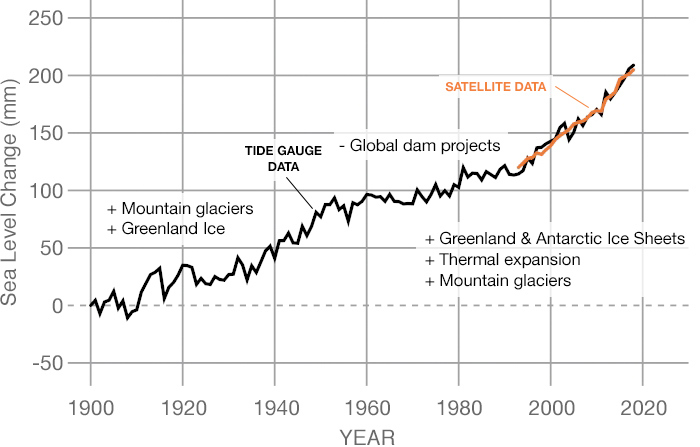Business
How climate change impacted Hurricane Ida, according to scientists

Climate 101 is a Mashable series that answers provoking and salient questions about Earth’s warming climate.
Storm scientists are still learning many things about hurricanes.
The short story is there are clear and troubling ways the continuously warming Earth is impacting these potent storms, while other impacts are less certain. For example, the surges of ocean water from hurricanes and their heavy downpours are worsening. Yet, how climate change is affecting storm intensification (which means stronger, more damaging winds) is an ongoing, hot area of atmospheric research, explained Phil Klotzbach, an atmospheric scientist at Colorado State University who researches hurricanes. Though, he added, there are certainly hints that some storms are growing stronger and may continue doing so as the planet warms.
“Hurricanes are really messy,” said Klotzbach, referencing how these storms are dynamic, churning atmospheric events with big influences from wind patterns, variable weather, and the oceans. Hurricanes are not as straightforward, for instance, as the warming climate’s influence on heat waves or melting ice sheets.
Below is a deeper look at how the changing climate impacts powerful cyclones like Hurricane Ida, an Aug. 2021 storm that took lives, ripped rooves off buildings, breached levees, and knocked out power to wide swathes of the New Orleans area.
Deluges and flooding
Hurricanes are producing heavier rains because the warming climate has amped the odds for storms to produce more rain, explained Brian Tang, an atmospheric scientist at the University of Albany who researches hurricanes.
As Mashable previously reported: “When air temperature is warmer the atmosphere can naturally hold more water vapor (heat makes water molecules evaporate into water vapor), meaning there’s more water in the air, particularly in many humid or rainy regions. For every 1.8 degrees Fahrenheit of warming (or one degree Celsius) the air holds about seven percent more water vapor. Earth has warmed by just over 2 degrees Fahrenheit since the late 1800s, resulting in more storms significantly juiced with more water.”
This means storms now have boosted odds of dumping significantly more rain.
“You’re loading the dice,” Tang emphasized.
Since the 1950s, the heaviest rains have increased over most areas where climate scientists have good data (like North America, Europe, and many other regions), a major UN Intergovernmental Panel on Climate Change (IPCC) report recently concluded.
So far, Earth has warmed by some 1.1 degrees Celsius, or about 2 degrees Fahrenheit, above 19th-century levels. If Earth warms to 2 C (or 3.6 F), which is an increasingly likely outcome, hurricane scientists expect rainfall rates within 100 kilometers (62 miles) of a storm’s center to increase by 10 to 15 percent. That portends major flooding during hurricanes.
Storm surge
Hurricanes can push violent, destructive surges of seawater into the coast. A hurricane’s powerful winds drive these surges. Ida’s surge was potent. But, crucially, sea levels are increasing as Earth’s great ice sheets melt into the ocean. That inevitably means higher storm surges.
“Sea level is rising,” said Klotzbach, noting how this results in more coastal areas inundated with damaging saltwater.

Sea level rise since 1900.
Credit: nasa
Sea levels have already risen by some eight to nine inches since the late 1800s. And as Mashable reported earlier this month: “Sea levels rose faster in the 20th century than in any prior century over the last three thousand years, the IPCC found, based on research of fossilized coastal creatures. By this century’s end, under intermediate (not extremely high or low) carbon emission scenarios, the IPCC predicts sea levels will rise by another 1.5 to 2.5 feet, and then continue rising.”
Already, hurricanes produce more destruction and property damage than they would have a century ago. Areas like Florida, the Texas coast, and other gulf states now have considerably more infrastructure and homes. Hurricanes have more targets. “They’re causing more damage,” emphasized Klotzbach. “There’s more people and stuff in harm’s way.”
With sea level rise, scientists expect storm surge damages to become increasingly worse this century, particularly in low-lying places (like Louisiana) and cities (like Tampa Bay) that are extremely vulnerable to these surges of water.
Stronger hurricanes?
Hurricane Ida rapidly intensified. (A tropical storm rapidly intensifies when its wind speeds increase by at least 35 mph over a 24-hour period.) An actively researched question in atmospheric science today is how the changing atmosphere will impact the intensity (wind speed) of storms. There is evidence, for example, that storms in the Atlantic Ocean have had a detectable increase in intensification events between 1982 and 2009, and that tropical storm intensity has increased globally over the last few decades.
Yet, many tropical storm researchers emphasize more storm observation is necessary, in the years and decades ahead, to truly know how climate change is affecting hurricane intensity.
For a foolproof way to say with certainty how climate change affects hurricane intensity, “we need to wait decades and see how the trend evolves,” said Falko Judt, a research meteorologist at the National Center for Atmospheric Research. “As usual, hindsight is 20/20.”
“It’s something that requires more research to understand,” added Tang, but also noted it seems like there’s been a recent uptick in the number of storms that have rapidly intensified.
The uncertainty lies in how scientists observe storms today, versus humanity’s limited view of storms before the 1980s. Today, scientists have state-of-the-art weather satellites and a fleet of aircraft gathering all sorts of information about hurricanes. But this 40-year-long, increasingly detailed observation period is much shorter than other climate records, like records for global temperature, drought, and wildfires. So when recent years show evidence of stronger storms, is it because they’re happening, or are scientists now seeing them happen with more advanced tools?
“There are indications that rapid intensification episodes have increased over the last decades,” said Judt. “This could be a sign of climate change ‘supercharging’ the ocean and atmosphere. But we’re also detecting rapid intensification better than say 40 years ago. So is this trend real or an artifact of better technology?”
It’s an open, evolving question.
Atmospheric scientists, however, can potentially tease out the impact climate change had on a storm like Ida with “attribution studies.” These are complex hypothetical computer simulations that assess “what would have happened if there was no global warming,” noted Judt. They show the influence climate change had on an extreme event. These attributions are often done with heat waves.
What’s certain, however, is the oceans are heating up as the climate warms, and warm oceans are “jet fuel for hurricanes,” explained Klotzbach. (Warmer oceans fuel tropical storms as more water naturally evaporates into the air, giving storms energy and moisture to intensify.) The extremely absorbent oceans soak up over 90 percent of the heat humans, due to fossil fuel burning, trap on Earth. The seas will continue warming beyond this century.
This ocean warming seems like it should easily portend stronger hurricanes. Ida definitely passed through some extremely warm waters. But when it comes to extremely dynamic processes like relatively short-lived, churning cyclones, it’s not that simple. “It’s pretty clear that — everything else equal — hurricanes intensify faster in a warmer world,” said Judt. “But everything else is not equal.” Future storms are a complicated mix of an atmosphere and ocean that are both interacting and changing. Wind patterns change too, said Judt. And warmer temperatures may actually act to stabilize the atmosphere, which isn’t good for storms (tropical storms form in unsettled, disturbed atmospheric environments), explained Klotzbach.
As the years and decades pass, however, the warming ocean may indeed win out over other factors, resulting in more intense storms, said Klotzbach. For example, in a world considerably warmer than Earth today (a 2 C world, where we’re almost certainly headed), climate projections currently suggest there may be a greater proportion of higher intensity storms. Yet, there’s currently no evidence there will be more storms overall.
Hurricane Ida, beyond being a deadly, destructive storm that rapidly intensified, is another critical data point that guides our understanding of future hurricanes. But it’s already clear that climate change is boosting the severity of deluges and storm surge. These impacts will only grow more severe as the climate warms.
-

 Entertainment6 days ago
Entertainment6 days agoApple Watch Series 9 vs. SE: A smartwatch skeptic tested both for 13 days
-

 Business5 days ago
Business5 days agoGoogle lays off workers, Tesla cans its Supercharger team and UnitedHealthcare reveals security lapses
-

 Entertainment6 days ago
Entertainment6 days agoThe greatest films on Prime Video right now
-

 Business6 days ago
Business6 days agoGoogle dubs Epic’s demands from its antitrust win ‘unnecessary’ and ‘far beyond the scope’ of the verdict
-

 Entertainment2 days ago
Entertainment2 days agoiPad Pro 2024 now has OLED: 5 reasons this is a big deal
-

 Business7 days ago
Business7 days agoApple: pay attention to emerging markets, not falling China sales
-

 Entertainment5 days ago
Entertainment5 days agoLoneliness in kids: Screen time may play a role
-

 Business4 days ago
Business4 days agoThe Rabbit r1 shipped half-baked, but that’s kind of the point





















